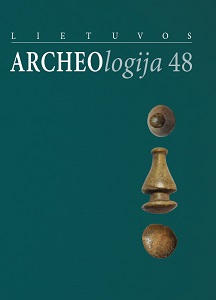ALICE’S ADVENTURES IN COMPUTATIONAL MODELLING OF THE SUB-NEOLITHIC BOUNDARY: CURIOUSER AND CURIOUSER DYNAMICS GOVERNING THE ADAPTIVE MORPHOGENESIS OF CULTURE
ALICE’S ADVENTURES IN COMPUTATIONAL MODELLING OF THE SUB-NEOLITHIC BOUNDARY: CURIOUSER AND CURIOUSER DYNAMICS GOVERNING THE ADAPTIVE MORPHOGENESIS OF CULTURE
Author(s): Christopher Barber Troskosky, Tianyu Chen, Katie Nicole TroskoskySubject(s): Archaeology, Cultural history, ICT Information and Communications Technologies, Prehistory
Published by: Lietuvos istorijos institutas
Keywords: Archaeology; Eastern Baltic; Neolithisation; Information Science; Computational Modeling; Self Organized Criticality; Frontier Zone Dynamics; Sub-Neolithic; Corded Ware; Cultural Morphogenesis;
Summary/Abstract: The Sub-Neolithic hunter-gatherer-fisher (HGF) groups and Corded Ware (CW) agro-pastoral group interactions within the Lithuanian portion of the Neman Basin around ~3000 BC did not follow the same patterns of agriculturalisation seen elsewhere in Europe during Neolithization. The variation of interaction in this agricultural frontier zone provides valuable insight into the way information exchange between groups drives the exchange of intercultural information and how information exchange between groups ultimately the adaptive morphogenesis of culture. This article’s primary author has already studied this outlier behaviour and the Unified Agricultural Frontier Model (UAFM) was proposed in volume 45 of this journal (Troskosky et al. 2019). The article presented in this volume is a companion piece to the 2019 publication which further explains and tests the mechanics underlying the UAFM. The UAFM applies self-organised criticality (SOC) to the hypothesis that marked cultural shifts are most likely to occur in response to increased levels of stress affect within a society. Stress affect is defined as the dissonance between encultured expectations of reality and phenomenologically lived reality within a population. To test this hypothesis, The Arithmetic Logarithm Illustrating Cultural Exchange (ALICE) model was developed; it provides confirmation that information exchange drives the behaviour of the UAFM across frontier zones. This model provides strong computational confirmation that information drives the behaviour of the UAFM across frontier zones. Theoretically, ALICE supports a general model for information flow between different cultures, facilitating corresponding cultural changes across any frontier. It models how increased levels of stress affect within interacting groups can lead to shifts of societal behaviour marked by a pattern of periods of equilibrium alternating with periods of disequilibrium. The results from the ALICE model and logical extrapolation of their effects in the UAFM demonstrate support for the eight new archaeological testable governing dynamics for information-driven adaptive morphogenesis of culture.
Journal: Lietuvos archeologija
- Issue Year: 2022
- Issue No: 48
- Page Range: 15-37
- Page Count: 23
- Language: English

